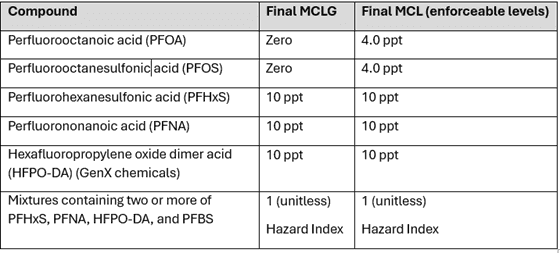
CUSTOMER FIRST NEWSLETTER
February 2025
WHAT ARE PFAS AND WHY ARE THEY A CONCERN?
Per- and polyfluoroalkyl substances (PFAS) are a group of man-made chemicals valued for their water- and stain-resistant properties. Often referred to as “forever chemicals,” PFAS are highly persistent in the environment, resisting degradation and accumulating in water sources, including drinking water.
Exposure to PFAS, even at low levels, is linked to significant health risks, including:
- Thyroid disorders
- Immune system suppression
- Developmental issues
- Increased risk of certain cancers
These chemicals typically enter drinking water through industrial discharges, firefighting foam, and landfill runoff, making them a growing public health concern.
EPA'S LANDMARK ACTION ON PFAS REGULATION
In April 2024, the U.S. Environmental Protection Agency (EPA) finalized the National Primary Drinking Water Regulation (NPDWR) for six PFAS compounds. This new regulation establishes Maximum Contaminant Levels (MCLs) for the following PFAS compounds:

ppt: parts per trillion, also expressed as nanograms per liter (ng/L)
MCLG: Maximum Contaminant Level Goal. An MCLG is the level of a contaminant in drinking water below which there is no known or expected risk to health. MCLGs allow for a margin of safety and are non-enforceable public health goals.
KEY HIGHLIGHTS OF THE REGULATION
The regulation includes:
Maximum Contaminant Levels (MCLs): These are specific limits set for six PFAS compounds to ensure water safety.
Hazard Index (HI): A health risk assessment tool used to evaluate exposure to multiple PFAS chemicals. The HI sums up the fractions comparing each PFAS level in water to health-based water concentrations.
Mandatory Monitoring: Public water systems must:
- Initial monitoring requirements must be completed by 2027.
- Conduct ongoing compliance monitoring after initial assessments.
Corrective Actions: Water systems with PFAS levels exceeding MCLs have until 2029 to implement necessary measures to reduce contamination.
Public Notification: Community water systems must notify the public of any MCL violations within 30 days. Beginning in 2027, these systems are also required to include PFAS data in their annual Consumer Confidence Reports
PROTECTING PUBLIC HEALTH THROUGH REGULATION
This regulatory milestone underscores the EPA’s commitment to safeguarding public health by reducing PFAS exposure. Advanced filtration technologies, such as activated carbon and reverse osmosis, are highly effective in mitigating PFAS contamination, aligning with the new standards.
LOOKING AHEAD
As governments and regulatory agencies establish stricter PFAS limits, it is crucial to stay informed about developments and take proactive steps to address these challenges. For public water systems and communities, the timeline provides an opportunity to implement advanced solutions, ensuring safer drinking water for all.
